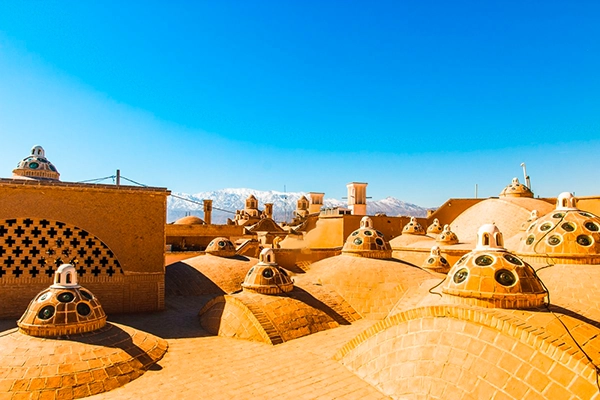
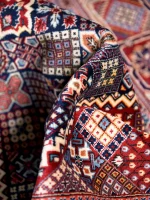
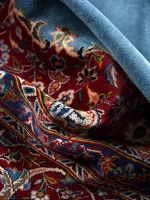
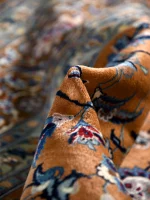
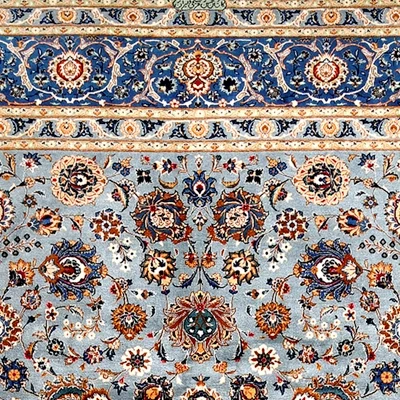
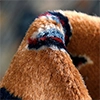
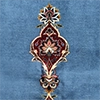
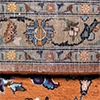
See this amazing Kashan Persian rug that implicates the old small pools in Persian kings’ houses with moving gold fishes inside the water. Its deep blue field conjures images of serene waters, reflecting the heavens above. The intricate patterns woven into the rug depict a myriad of delicate floral motifs, mesmerizing in their intricacy and elegance.
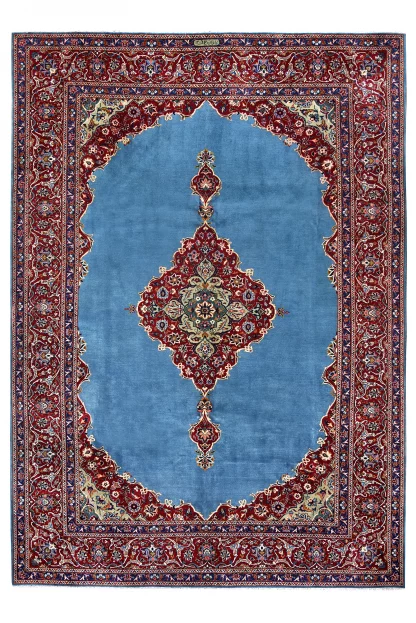

What sets this hand-woven Persian Kashan rug apart is its vibrant red border, framing the tranquil blue expanse. Like a fiery summer, the red margins encapsulate the serene blue field, creating a captivating contrast that evokes a refreshing coolness in the midst of hot summers.
The harmonious blend of calm blue and passionate red evokes a sense of balance, reminding us of the interplay between serenity and intensity in life.
This is the art of old. In Kashan, the art of velvet weaving and the production of silk handkerchiefs had been practiced a thousand years ago. Also skilled Kashan artisans who had meticulously hand-woven Kashan carpet in the past seven hundred years. Each hand-knotted Persian Kashan rug tells a story full of the secrets of bygone years.
As you see below, in our unique collection, we have carefully selected exquisite and precious Kashan rugs with their unique stories. With skill and finesse, we have curated an unparalleled collection for those interested in purchasing handmade Persian Kashan rugs.
See our exquisite collection of hand-woven Persian Kashan rugs, spanning from 1960 to the present day. Confident in our rug quality, we’re here to help you choose with peace of mind. Ask us anything!
Let these exquisite hand-knotted Persian Kashan rugs adorn your space, bringing the timeless allure of Persian artistry into your home.
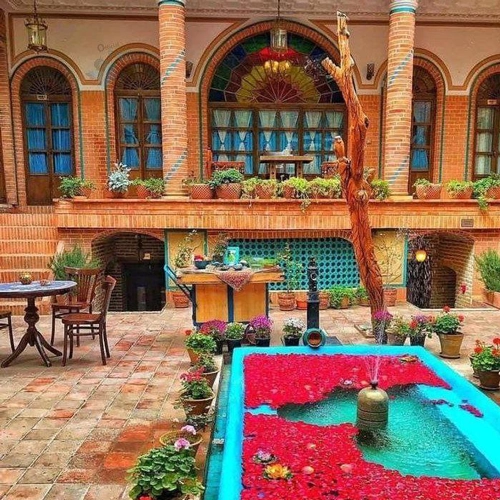
Artisans in Kashan were involved in weaving industry before Marco Polo’s trip to Iran in the 7th century AH. These weavers were drawn to various textile and velvet arts and gained attention then. Famous individuals such as Knight Sheridan and Antoine Shirley speak of multiple weaves and praise their trip to Kashan.
One of the Christian preachers who traveled to Kashan in 1600 AD, Peter Cartwright, speaks of carpets, rugs, tiles, and Kashan ceramics as unique Iranian handicrafts.
Alongside the Renaissance period in Europe, Kashan carpets were also produced. The oldest Kashan carpet dates back to the early 17th century AD, and after this period, we must mention Polish or Polish carpets. Many of these were woven in Kashan from the late 17th and 18th centuries until the mid-19th century, during which there was no severe activity or growth in Kashan carpets.
Mullah Mohsen was an importer of Merinos wool in Manchester about 120 years ago and engaged in carpet weaving and producing exquisite carpets. Since then, a resurgence and remarkable growth in making quality carpets began in Kashan.
In addition to producing carpets using Manchester wool, which in the past was woven into Kashan velvet carpets, many delicate rugs were woven entirely from silk, and even very exquisite silk carpets were sometimes produced.
In addition, woolen carpets and rugs made from excellent lamb wool are abundant in Kashan carpets. Their delicate and shiny quality adds to the beauty of Kashan carpets. In addition, the precise knotting and use of short fibers play a fundamental role in the delicacy and weight of Kashan carpets.
Kashan runners are usually 3, 4, and 5 meters long and 80, 90, and 100 centimeters wide. The dimensions of Kashan carpets vary greatly, but they typically conform to the following size list (larger sizes exist, but they are rare due to limited demand) (since the carpets are handwoven, the numbers below are approximate and not exact.):
One of the most unique designs in Kashan carpets is attributed to the prominent “Mohtasham” pattern. Its origin dates back to the late 19th century and features exceptional and distinctive patterns that deviate from traditional norms.
This carpet, known as the “Secretary of Carpet Industries,” is the result of a collection of extraordinary patterns such as “Zelo-Soltan,” “Haj Khanoomi,” “Special Afshan,” and “Sara-Sar (Overall)”.
The symbolic elements used in the weaving of authentic Kashan carpets include the “Shah Abbasi (Palmette flower) Cluster”,”Khatai Flower,” “Eslimi (Arabesque) Branches”, “Shah Abbasi (Palmette Flower) Leaf,” various Eslimi (Arabesque) shapes, geometric flowers, Circular and Rhombic-Shaped Toranj (Medallion) designs.
Kashan carpets have a distinct style in pattern and color. It can be compared to a Toranj (Medallion), a circular, oval, or diamond-shaped design placed in the center. Intricate patterns of flowers and four-cornered carpets known as “Lachak” and “Toranj” (Corner & Medallion) decorate the carpet. Upon closer inspection, one can distinguish the intertwined colors of lacquer, indigo, and ivory within the framework of this design.
This style of carpet has been produced in various qualities from the past until today and can be considered one of the prominent features of Kashan rugs.
However, among the various types of Kashan carpets, especially those produced in the past, some have signatures, meaning the name of the designer or maker is woven into it and serves as an identification card for Kashan carpets. Regarding the classification of unsigned carpets, you can research and investigate with the guidance of several reputable websites with experts in this field. The “CarpetShip” website also announces its readiness to provide accurate information. It is worth noting that many intricate designs have been created for Kashan carpets, and you can find information related to patterns and designs on this website, especially in the section dedicated to Kashan carpet patterns and designs.
Calculating knot density refers to determining the number of knots per square inch in a carpet, measured in kpsi. One of the evaluation criteria for Kashan carpets’ value is its high knot density or kpsi. However, knot density alone cannot be the primary indicator of carpet valuation. Nevertheless, it can sometimes help with carpet quality. A higher number of knots leads to a more delicate and distinctive carpet pattern. Naturally, this requires using finer raw materials, i.e., thinner fibers. It also involves the participation of a highly skilled weaver, especially someone with excellent weaving speed who can tie one knot every 10 seconds and 360 knots in an hour.
If someone intends to produce a 6 square meter carpet with a knot density of 150 knots per square inch, it takes approximately one year and three months to complete the weaving process. This estimate is based on eight hours of work per day.
In conclusion, the key points are as follows:
In carpet weaving, especially in the hand-woven carpet industry in Kashan, a unit called “raj” (knot) is used to measure each knot. This widely recognized term serves as a standard measurement. The total number of knots in a carpet is determined by counting these knots along a 7-centimeter length.
Kashan carpets are usually divided into three qualities: 1) woolen, 2) delicate woolen, and 3) Pile. The number of knots per unit area in these carpets varies from 40 to 30 raj depending on the complexity and delicacy of the natural fibers used and the intricate patterns woven into them.
In rare cases, Kashan’s floral silk carpets are made with 50 to 45 raj knots, although this number is limited.
Beyond these various characteristics, exceptional examples can be found in Kashan carpets, such as full miniature silk Kashan carpets. These precious pieces showcase the pinnacle of artistry and creativity, displaying unparalleled delicacy achieved by skilled artisans of the past, including prominent figures such as Tafzoli, Madah, Derakhshesh, and Tabatabai. These artisans produced finely crafted carpets with 80 to 60 raj knots in full silk Kashan, rare among exceptional creative works.
A crucial point regarding this type of carpets is that their weaving is done by women using their fingers, rather than using the metal hooks that are commonly employed today. Consequently, these carpets are much denser and more durable, possessing a unique beauty rooted in their authenticity. They are exceedingly rare in the global market and draw particular attention from collectors.
Kashan carpets have a long-standing reputation for authenticity and quality. Many of these carpets are designed by renowned artists, and expert evaluators can verify their authenticity. However, some Kashan carpets are produced commercially with average quality, and this practice continues today. Additionally, rugs are woven in surrounding areas such as Aran, Ardestan, and Natanz, but the quality of these carpets is significantly lower than that of authentic Kashan carpets.
Kashan’s exceptional designers often use the best raw materials, natural and stable dyes, and skilled weavers to create unique and valuable works of art. Some authentic Kashan carpets take several years; the designer typically signs them. It is essential to be meticulous when choosing an authentic rug and seek assistance from experienced experts.
Authentic handwoven Kashan carpets from Iran have various designs, particularly in the past. Due to their intricate weaving, they hold a prominent place in Iranian art. Some of the most common designs include “Lachak and Toranj” (Medallion & Corner Design) or “Toranj-va-Mehrab”, which have made Iranian Kashan carpets famous. Without a doubt, there are also designs such as “Afshan” (Overall flower design), “Boteh Jegheh,” “Gol-e-Dani va Darakhti” (Vase & Tree Design), “Mehrabi Yek Tarafah” (In this design, there are two columns situated on either side, and the ceiling pattern of a mosque is positioned atop these two columns. As one moves upward from the base of the blueprint, the pattern does not repeat and is distinct with different floral motifs and designs.), “Shikargah” (Hunting design), “Vagireie,” “Tasviri” (Pictural carpet), and “Shah Abbasi Gol-Dorosht” (Palmette big flower design), that are produced in both Tornj and Afshan. Additionally, designs such as Gol-e-Dani Haj Khanoomi, and Zelolsoltan were made with precision and attention to detail in the past in the city of Kashan. Among these various designs, the “Mohtasham” design is considered the most excellent.
It is important to note that one type of tribal carpets, Joshaghan (Joshaghan-e-Ghali, situated around 60 kilometers from Kashan, derives its name from the Persian word “Ghali,” which means “carpet.” This village earned its distinctive name due to its central role as a hub for handwoven carpet production in the area.) , whis are produced in the Kashan region. These designs are geometric and have global fame.
Authentic handwoven silk Kashan carpets from Iran are made with natural silk. This natural silk is obtained from the silkworm’s cocoon as a long filament. The silk cocoons are then spun into multi-meter-long skeins. Skilled artisans in dyeing workshops mix this raw silk with various colors to create intricate designs.
In the past, Kashan carpets were exclusively made of natural silk, with unique characteristics such as thinness, lightness, high density, and a lustrous appearance. These advantages, combined with its lightweight, made it a superior choice.
It is important to note that due to the high cost of natural silk, one must be very careful when purchasing. Unfortunately, the widespread use of artificial silk has made it necessary to consult experts for guidance. Artificial silk (rayon) is made from cellulose fibers and can be identified by two methods:
1- To identify natural silk, one can pull out a small knot from the carpet and burn it. It will give off a smell similar to burnt human hair. The knot will turn into a black ball after burning, and its color will turn black. Additionally, rubbing it with your hand will give you exceptional warmth.
2- Burning artificial silk will give off a smell similar to burning paper. After burning, it turns into a soft ash and white powder.
Kashan woolen carpets from Iran are very sturdy and thick. They are made from the wool of good breeds of sheep. These wools are obtained during the shearing season and have special fibers with natural properties for the body.
Contrary to popular belief, purchasing an Iranian Kashan carpet within your budget is possible. This means that there is diversity in quality, knot count, and designs, especially in authentic Iranian Kashan carpets from the past. This diversity allows you to have different choices. Our information in the next question about what determines the value of an Iranian Kashan carpet may be part of the answer to this question.
The oldest Iranian carpet, an authentic Kashan, is located in the Calouste Gulbenkian Museum in Portugal. This carpet, made entirely of precious silk, was woven in Kashan in the early 16th century. Its dimensions (230 cm by 180 cm) make it one of the most valuable works of art in its category.
Writings from the 17th and 18th centuries attest that Kashan was known as a famous center for producing court carpets. In addition to natural silk, these carpets also used silver and gold thread and are displayed in exhibitions and private collections today. The Kashan carpet incorporates two elements and separates these two main elements over time, with a long period of inactivity of almost two centuries.
The people of Kashan, especially in weaving, are very active and creative. Another example of Kashan’s silk carpets is from the 10th century, which depicts hunting scenes. This carpet, partly made of silver brocade, is on display at the Museum of Art and Industry in Vienna and is considered a prominent work of art from Kashan.
Due to the wide variety of materials and patterns, as well as the history of carpet designers and the skills of weavers, questions arise that impact the value of carpets. Are the carpet designers well-known and famous? Have the weavers been able to implement their skills in weaving rugs in the best possible way?
The answers to these questions can explain the value and importance of Iranian Kashan carpets. The city of Kashan has a history that dates back more than five thousand years, and this artistic history in carpet weaving has been passed down from mothers and grandmothers to daughters.
One of the valuable symbols that indicates the history of carpet weaving in Kashan is the registration of the skill of weaving delicate carpets. In 2010, an authentic Iranian hand-woven Kashan carpet with the code 00383 was registered by UNESCO as one of Iran’s heritage works. This action demonstrates the value and importance of this art on a global scale.
It should be noted that carpets produced in Kashan in the past, especially antique and semi-antique carpets, are considered examples of the highest quality and beauty. These productions have made Kashan carpets one of the best in the world, and they have many fans inside and outside Iran. Thus, there is a close relationship between value and fame in this field.
Get informed about exclusive sales , free delivery and discount coupons %